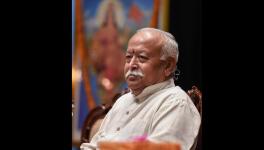Yogi’s ban on Illegal Slaughterhouses Culled Livelihood of Bahraich Butchers
Representational use only.
Bahraich: At the busy Chandpura intersection in Bahraich district in Uttar Pradesh (UP), a big butcher shop that was once famous for selling every type of meat now struggles to sell 10 kg of goat meat or even chicken.

Mohammad Athar meat shop in Bahriach
The owner, Mohammad Nizam (name changed), is scared to talk with the media. After much coaxing, he opens up. “I owned one of the biggest meat shops in Bahraich and had a good number of customers who, in turn, sold it in every nook and corner of the city. Now, people are not only scared to sell meat but also consuming it,” says Nizam, who belongs to the Qureshi class.
Life for Nizam and other butchers took a 360 degrees turn in 2017 when the Bharatiya Janata Party’s new chief minister Yogi Adityanath banned illegal slaughterhouses, impacting the lives and livelihood of thousands of people directly or indirectly involved in the trade.
Now, Nizam daily worries about providing two square meals to his family. “Back in 2017, when the crackdown on slaughterhouses and unlicensed butchers started, we shut our shops for almost a year, forcing a large number of butchers to either leave the city or change their trade. Apprehensive of police action, several of my neighbours moved to big cities like Unnao, Kanpur and Hyderabad to work as daily wagers,” he says adding that “several of my distant relatives have also quit the trade”.
Due to the growing insecurity and uncertainty, Nizam does not want his sons to run the traditional family business.
Adityanath’s predecessor Akhilesh Yadav had ordered his administration to ensure that the abattoirs were run on ISO guidelines along with proper waste and water management. A year-and-a-half later, a budget was also allocated for 10 municipal corporations across the state. However, the measures could not be implemented with Adityanath coming to power.
According to Ajay Sharma, a senior official of the Uttar Pradesh Pollution Control Board (UPPPCB), there are about 37 licensed slaughterhouses in UP which supply meat across the state. “There are around 37 or 38 slaughterhouses in Uttar Pradesh operating as per the government and pollution control board guidelines. Hundreds of illegal slaughterhouses were shut down in 2017,” he says.
Another senior officer when asked about the impact caused by the ban said, “Do not report on this issue; it defames the nation. Please, report things in the national interest.” The majority of these licensed slaughterhouses are in the export business, he said. “The major chunk of the meat is exported to Muslim nations because it is Halal and costs low. A Bareilly private slaughterhouse which exports meat caters for Bahraich. To set up a slaughterhouse one needs a plot of a minimum 10 acres, working capital of more than Rs 1 crore and licence to kill animals who are more than 15 years."
UP was once the highest producer of meat but production fell from 1.3 million tonnes (MT) in 2014-15 to 1.16 MT in 2019-20. On the other hand, meat production in Maharashtra and Andhra Pradesh increased in the same period.
Mohammad Athar (name changed) shut his shop for more than a year and instead sold cooked chickpea and rice and biryani, which fetched him merely Rs 200 a day compared to about Rs 600 before 2017.
“Half of the 200 meat shops in Bahraich before 2017 have now been shut down. Meat sellers who did business from their houses are also on the verge of extinction because of the fear of the police. The number of meat sellers, estimated to have been around 5,000-6,000, has drastically reduced because of the exodus,” Athar said.
“Some families went without food for nights and had to take loans for feeding their children,” Athar, who has to repay a loan of Rs 3 lakhs he took for getting his daughter married, said.
According to the 2011 census, around 38.48 million Muslims in UP constitute about 19% of its population but only 25.6 % of them are employed with a large proportion of them engaged in less regular and low-income occupations like selling meat.
The writer is a freelance journalist. With inputs from Azeem Mirza.
Get the latest reports & analysis with people's perspective on Protests, movements & deep analytical videos, discussions of the current affairs in your Telegram app. Subscribe to NewsClick's Telegram channel & get Real-Time updates on stories, as they get published on our website.
























